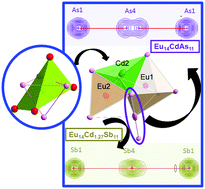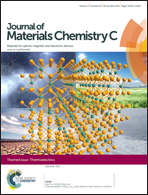Non-stoichiometric compositions arising from synergistic electronic and size effects. Synthesis, crystal chemistry and electronic properties of A14Cd1+xPn11 compounds (0 ≤ x ≤ 0.3; A = Sr, Eu; Pn = As, Sb)†
Abstract
The structural variability in terms of existence of stoichiometric and nonstoichiometric compounds in the well-known “14–1–11” family has been investigated. Four such compounds, Eu14CdAs11, Sr14Cd1.06(1)As11, Eu14Cd1.27(1)Sb11, and Sr14Cd1.30(1)Sb11, synthesized by both flux and traditional solid-state methods, have been structurally characterized by single-crystal X-ray diffraction. They are all isotypic, forming with the Ca14AlSb11 structure type (Pearson code tI208, tetragonal space group I41/acd). Their average structure can be described as space-filling packing of distorted [APn6] octahedra, [APn5] trigonal bipyramids, and [CdPn4] tetrahedra, where Pn denotes As or Sb, and A stands for Eu or Sr. Interstitial sites are partially occupied by Cd atoms, giving rise to the chemical formula A14Cd1+xPn11. The interstitial atom can be seen as forming a cluster, reminiscent of the empty substructure unit in the gamma-brass cluster (also known as “tetraederstern”). Robust cation–cation interactions exist in the structure and might be a natural response of the electronic structure to compensate for the apparent electron deficiency and in order to optimize the bonding interactions. The electronic structure calculations for idealized Sr14CdSb11 revealed that the Fermi level falls near the edge of the valence band, which suggests poor metallic conductivity. The analysis of the volume of coordination polyhedron and that of the Voronoi cell indicates that the content of Cd atoms in the interstitial site is limited by the available “free volume” within the complex tetrahedral unit. This free volume is induced by the instability of the hypervalent [Pn3]7− anion, which in turn is related to the increasing size of pnictogen atoms, and to some extent, by the type/size of the countercations.

- This article is part of the themed collection: The Chemistry of Thermoelectric Materials

 Please wait while we load your content...
Please wait while we load your content...